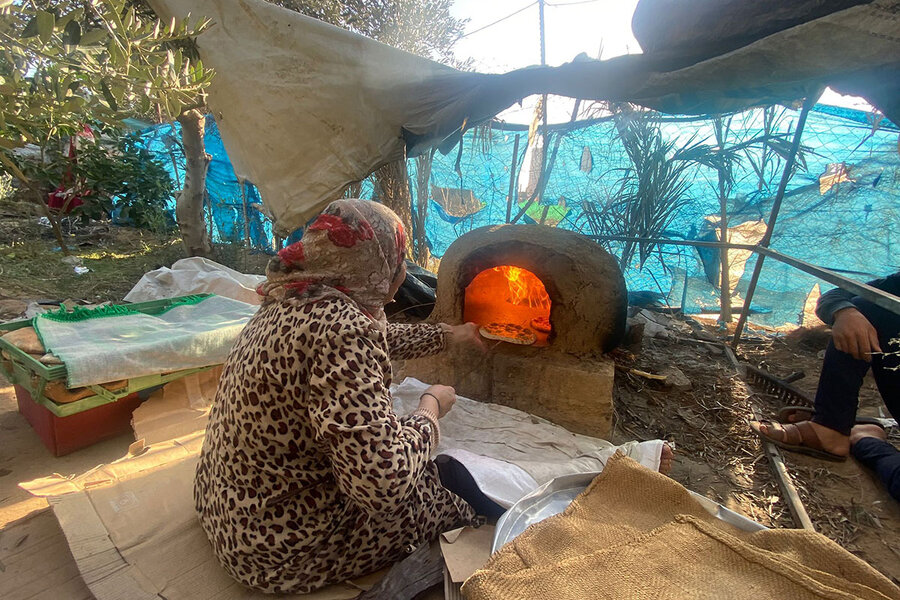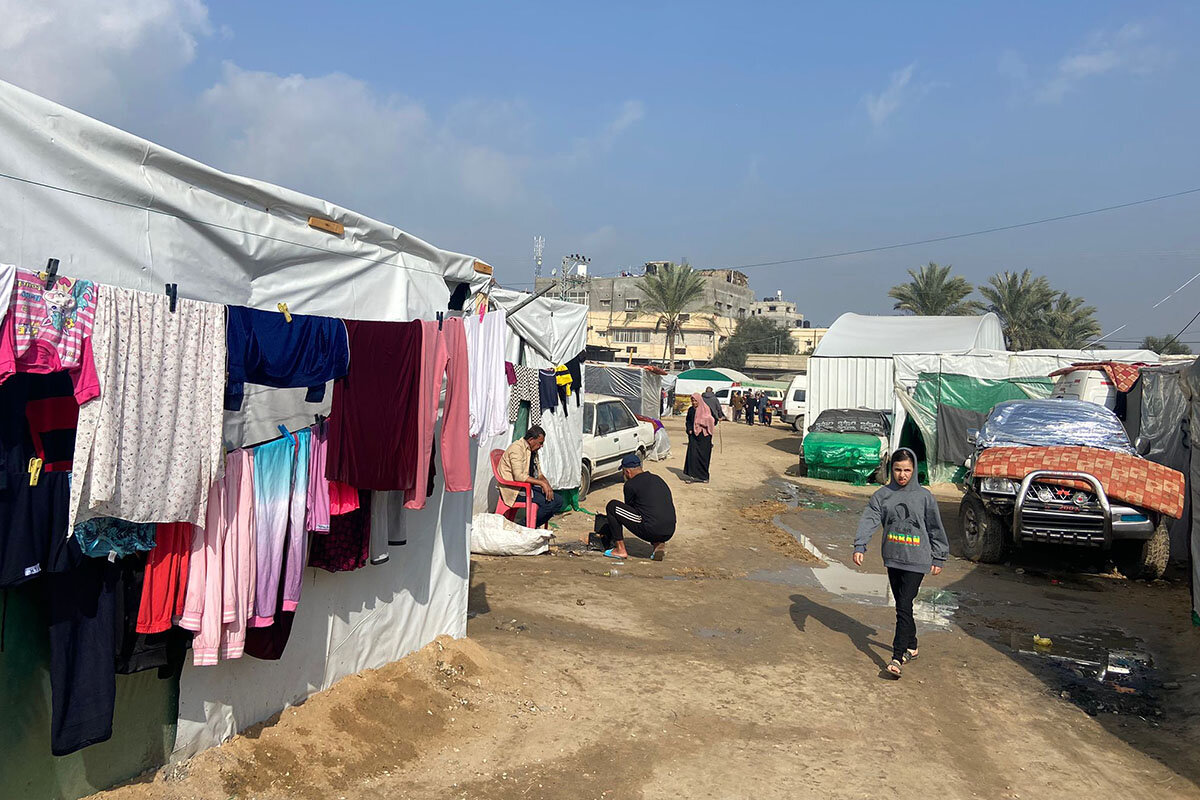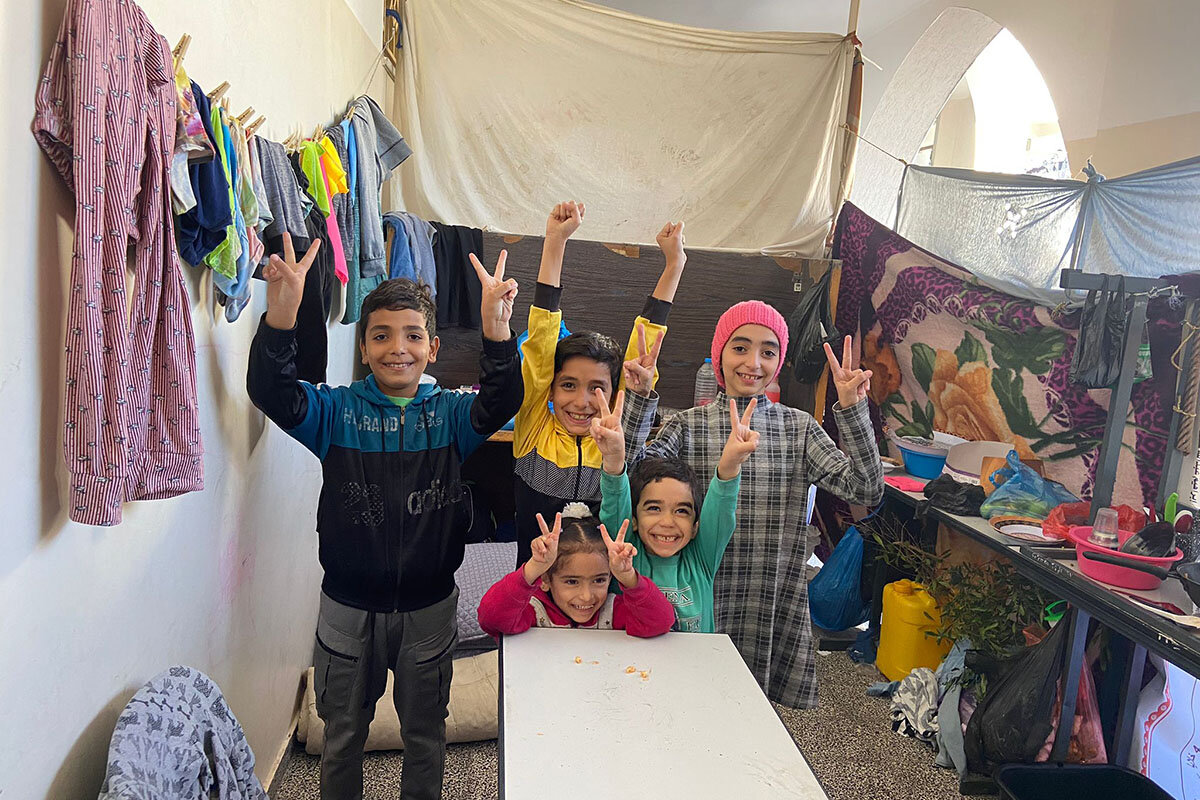‘This is a war that starves you’: For Gaza, hunger is a new enemy
Loading...
| Rafah, Gaza Strip; and Amman, Jordan
Kifaya Al Kafarna, a housewife from Gaza City who is currently living with 27 members of her extended family in a school library in Rafah, cannot remember the last time she ate a full meal.
After weeks of struggling to find shelter amid Israeli airstrikes, Ms. Kafarna – like hundreds of thousands of others in Gaza – is facing an even more acute crisis: starvation.
“There is nothing available in the markets: no flour, no water, no food,” Ms. Kafarna says, her voice trembling with exhaustion. “I am glad we have a place to stay, but we can’t find anything to eat.”
Why We Wrote This
A story focused onAs if being chased from pillar to post by Israeli missile fire was not enough of a trial, Gaza residents are now facing the prospect of starvation as humanitarian aid dries up.
“Half the population are starving,” United Nations World Food Program Deputy Chief Carl Skau told reporters in New York on Thursday, after visiting the Gaza Strip. “Nine out of 10 are not eating enough, not eating every day, and don’t know where their next meal is going to come from.”
With the end of the recent humanitarian pause in the fighting between Hamas and Israel, food aid is now only trickling into Gaza, U.N. officials say, and black market prices are soaring.
A World Food Program survey carried out during the cease-fire in late November found that 97% of households in northern Gaza and 83% of households in southern Gaza reported inadequate food consumption – one meal a day or less. It also revealed that 50% of Palestinians in northern Gaza and 33% in southern Gaza faced severe hunger.
These numbers are thought to have climbed further since the Israeli army resumed its operations on Dec. 1. Parents say they are going without food to ensure their children get half a pita bread or a bowl of boiled wheat each day.
Vanishing vegetables
The prices of what little food is left on the market are skyrocketing. Twenty-five-kilogram sacks of flour sell for $120, which is 15 times the normal price; chickens, when they can be found, cost $7 a kilo, more than twice the prewar price; and even za’atar, an affordable dried thyme and sesame mix that was once a breakfast staple in Gaza, has doubled in price.
But the rarest, most sought-after food items are fruit and vegetables.
As an ambulance rushes another bombing victim into the Al-Aqsa Hospital in the southern Gaza district of Deir al-Balah, Mohammad Al Taaban calmly sets out his vegetable stall on the street outside, lining up a few crates of green peppers, tomatoes, and lemons.
The owner of a small greenhouse farm in central Gaza, Mr. Taaban is one of the few who have vegetables for sale. A crowd instantly forms around him; his stock will not last long. In a matter of minutes he has sold out.
“It is remarkable how quickly the vegetables vanish before my eyes,” Mr. Taaban says as customers eagerly sort through bell peppers. “People buy them instantly,” even though prices have risen tenfold since the war began, and few shoppers can afford to buy more than a kilo or so of produce.
Mohammed Al Qazzar walks away with a small bag of sweet peppers and tomatoes, holding it up like a prize. He says his find will be greeted with celebrations back home. It has been a week since the last time they ate vegetables.
Food shortages and hunger in Gaza are affecting all, demolishing any remaining class barriers. Mr. Qazzar’s wealthy neighbors, who once owned their own businesses, now knock on his door regularly, pleading for bread.
“This is not a normal war,” Mr. Qazzar says. “This is a war that starves you, that stresses you, and pressures you to find food, fuel, and water all day.”
That pressure is weakening law and order. “I saw it with my eyes that people in Rafah have started to decide to help themselves directly from the [aid] trucks out of total despair,” the head of the U.N. Relief and Works Agency, Philippe Lazzarini, said this week. “They eat what they have taken out of the truck on the spot.”
“We have nothing”
The U.N. continues to bring in cans of tuna, high-energy biscuits, and flour through the Rafah crossing on the border with Egypt, but officials say distribution of this limited aid is complicated by Israeli government restrictions, Israeli military operations, and makeshift tents pitched in the streets by some of the million or so displaced people crowding into Rafah.
“The needs that we are meeting are really nothing,” Mr. Skau warned. “The humanitarian operation is collapsing.”
“The United Nations cannot support a population of 2.2 million people with humanitarian assistance – it is a Band-Aid,” said Lynn Hastings, the U.N. humanitarian coordinator for the occupied Palestinian territory in a virtual press briefing on Wednesday from Jerusalem. “We need to see the commercial sectors having access to bring things into Gaza. We need the markets to be open for fresh vegetables.”
Meanwhile, limited U.N. flour is being resold by recipients on the black market, and food coupons are in short supply. Kamila Abu Khader wanders the Al-Aqsa Hospital courtyard begging for spare U.N. food coupons to feed her six daughters and four sons.
Having been displaced three times, she says the food shortages and hunger are only getting worse.
Amany Al Silk says the obstacles have been growing more insurmountable each day since she was displaced from her home in the Shujaiyya neighborhood of Gaza City in late October.
She now lives with eight other people in a 60-square-foot makeshift tent pitched outside a classroom at a public school in Rafah, without electricity or water, and she spends her days roaming the neighborhood in search of food scraps and kindling.
When she finds nothing to use as fuel, Ms. Silk and her husband burn library books and the odd student notebook to cook meals. They walk miles each day to visit relatives to see if they have any spare food; today they came back with two cans of beans to feed themselves, her five children, her sister-in-law, and a niece. Yet they could not find any kindling to cook or warm them.
“In previous wars there were Israeli airstrikes, sometimes artillery shelling, but not all of this in addition to being forced out of your house and starving,” Ms. Silk says. “We have never seen a war like this.”
“My children keep asking me for dessert, for rice and milk pudding,” she says wearily, head in hand. “We have no milk. We have no rice. We have nothing.”








